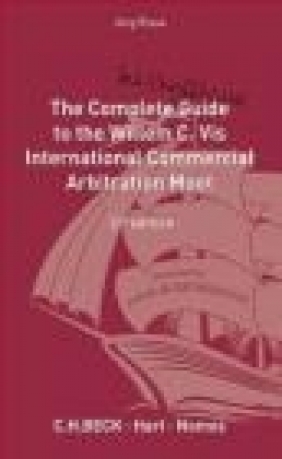The Complete (but Unofficial) Guide to the Willem C Vis Commercial Arbitration Moot
Jorg Risse
The Complete (but Unofficial) Guide to the Willem C Vis Commercial Arbitration Moot
Jorg Risse
- Producent: Hart Publishing
- Rok produkcji: 2014
- ISBN: 9781849467599
- Ilość stron: 210
- Oprawa: Miękka
Niedostępna
Opis: The Complete (but Unofficial) Guide to the Willem C Vis Commercial Arbitration Moot - Jorg Risse
Eleven teams of student participants attended the first Willem C Vis International Arbitration Moot in 1993/1994. Twenty years later 290 teams from 67 countries plus a huge number of coaches and arbitrators gathered in what is now considered one of the largest international arbitration events in the world. The cases dealt with are based on an international sales transaction governed by CISG, including procedural issues of arbitration. This book is meant for participants of the Vis Moot. It provides the reader with step-by-step practical advice in order to maximise his or her experience. It explains registration and offers tips on finding and organising the team, analysing the case, writing memoranda, presenting the case in the oral pleadings and organising the trips to Vienna or Hong Kong. Any student contemplating taking part in the so-called 'Moot Experience' will find the information needed to make the Vis Moot a real lifetime experience.I. The Vis Moot: A Lifetime Experience 1. The Vis Moot Teaches You Invaluable Skills 2. The Vis Moot is a Tough Challenge 3. The Vis Moot is a Stepping Stone for Your Career 4. The Vis Moot Will Show You the "Real Life" 5. The Vis Moot is Meeting Nice People from All Over the World and Having Fun 6. Up Close and Personal: Interview with Professor Eric E. Bergsten II. The Vis Moot: Facts and Figures 1. What is a "Moot Court"? 2. What is the Vis Moot? 3. Why Apply for the Vis Moot 4. History of the Vis Moot 5. The Timeframe of the Vis Moot 5.1 The Distribution of the Vis Moot Problem 5.2 Deadline for Requests for Clarification 5.3 Closing Date for Submission of Registration Form, Payment of Registration Fee Due 5.4 Memorandum for Claimant Due 5.5 Memorandum for Respondent Due 5.6 Official Welcome and Reception 5.7 General Rounds of Argument 5.8 Elimination Rounds of Argument 5.9 Awards Banquet and Gala Lunch III. How to Start 1. Composition of the Teams 1.1 Eligibility 1.2 The Selection Process 1.3 The Number of Students in a Team 2. What Must Be Done to Register? 2.1 Registration Process for the Vis Moot in Vienna 2.2 Registration Process for the Vis Moot (East) 3. Team Building 3.1 Why Is Team Building so Important? 3.2 Some Suggestions for Team Building 4. The Benefits of Having a Coach and How to Find One 5. Getting to Know the Subject Matter 6. Kick-Off Meeting 6.1 A Timetable 6.2 The Resources 6.3 The Assignment of the Issues 6.4 The Introduction to the Vis Moot Memoranda Writing Style 7. The Costs of the Vis Moot and the Possible Ways of Funding 7.1 The Costs 7.2 The Possible Funding Sources 8. Start Visa Application on Time IV. How to Write Effective Memoranda 1. The Moot's "Written" Phase 1.1 Course of the "Written" Phase 1.2 The Basic Structure of Your Memorandum 1.3 Formalities and Tips for Brushing Up Your Memorandum 1.4 Special Rules for the Memorandum for Respondent 1.5 The Grading of Your Submission 2. Reality Check: Submissions in International Arbitration 2.1 The Course of Written Submissions in International Arbitrations 2.2 The Typical Content and Format of Written Submissions 2.3 The Cultural Divide Revisited: Different Styles of Briefs 3. Ground Rules for Writing Effective Submissions 3.1 Rule 1: KISS - Use Short Sentences 3.2 Rule 2: What Matters Most - Subject + Verb 3.3 Rule 3: Choose the Right Subject and Apply That Subject Consistently 4 3.4 Rule 4: Choose Wisely Between Active Voice vs. Passive Voice 3.5 Rule 5: Put the Power into the Verb, Avoid Nominalizations 3.6 Rule 6: Delete Adjectives and Adverbs 3.7 Rule 7: Do Not Overuse Legalese and Lawyerisms 3.8 Rule 8: Use Headings Effectively 3.9 Rule 9: Avoid Spelling Errors 3.10 Rule 10: Always Start by Indicating the Issue 4. Recommendations for Advanced Writing (Or: Rules For Winning) 4.1 Recommendation 1: Persuasion Triggers - The Hidden Power of the Word "Because" 4.2 Recommendation 2: Use Enumerations to Become More Persuasive 4.3 Recommendation 3: Use Evidence and Exhibits Effectively 4.4 Recommendation 4: "First Impressions Count, Last Impressions Stay" 4.5 Recommendation 5: Quote Powerfully 4.6 Recommendation 6: Create Images in Your Readers' Minds V. How to Present Your Case Before the Arbitral Tribunal 1. The Setting of the Oral Pleadings 1.1 The Venue 1.2 The Arbitrators 1.3 The Number of Oral Hearings and the Number of Team Members Involved 1.4 The Available Time 1.5 The Typical Course of the Oral Pleading 1.6 The Grading System Used 2. Reality Check: Oral Pleadings in International Arbitration 2.1 Civil Law Style vs. Common Law Approach 2.2 Importance of Oral Pleadings
Szczegóły: The Complete (but Unofficial) Guide to the Willem C Vis Commercial Arbitration Moot - Jorg Risse
Tytuł: The Complete (but Unofficial) Guide to the Willem C Vis Commercial Arbitration Moot
Autor: Jorg Risse
Producent: Hart Publishing
ISBN: 9781849467599
Rok produkcji: 2014
Ilość stron: 210
Oprawa: Miękka
Waga: 0.3 kg






























